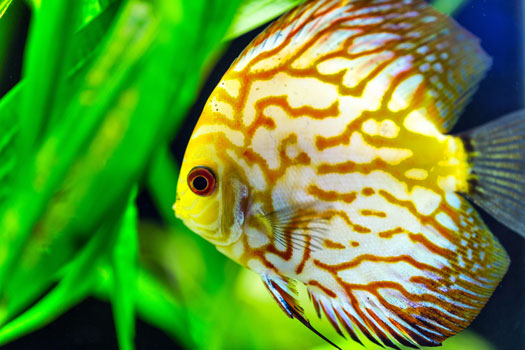- Your shopping cart is empty!
Why Do Fish Get White Spots?

When you see white spots on your fish, it means they’re infected with a disease. The white spots develop from the ciliate protozoan Ichthyophthirius multifiliis, which is commonly known as “ich” (pronounced “ick”) and is one of the most common fish diseases. Ich often evolves into blister-like lesions that look like white spots on the scales and/or fins. Sometimes the disease only affects the gills, in which case you won’t see any white spots. This infectious disease can be prevented and also treated fairly easily. The aquarium experts at Aquatic Warehouse, a leading provider of high-quality fish tank supplies, explain the reasons ich develops and how to prevent it.
Beginning Stage of Ich
First, the parasitic trophont lives inside of the host fish. Then, the trophont causes the host fish to suffer tissue damage and ultimately kills the host. The flesh of the dead host continues to feed the parasite as it grows into a mature trophont. Upon maturity, the parasite leaves the dead host and collects on the sides and bottom of the aquarium, where it secretes a cyst wall and begins to reproduce as tomonts and further divides into numerous theronts. Then the theronts make their way out of the cyst wall and swim and hunt around for fish to prey upon, which continues the cycle and prolongs the disease. Once of one your fish develops ich, the others in your aquarium allow the disease to spread. As the disease progresses, the fish will become more irritated and distressed, and ultimately they will die if left untreated.
Pre-Existing Conditions
In some instances, ich can come from the previous environment where the fish were obtained, but more often it’s inside the fish. Always be careful where you get your fish—they go through several environmental changes before they end up in your aquarium. At Aquatic Warehouse, the fish systems have multi-$1000 ultraviolet light sterilizers that eradicate free swimming protozoan and bacterial problems. Many online and smaller pet stores don’t have UVs, so be aware that many times you get what you pay for. Also, try to make your aquarium as uninviting to ich as possible. It’s a good idea to quarantine new fish for about 2 weeks before you place them in their new home/main tank. Make sure the quarantine tank is cycled just like a display tank. Keep an eye on them while they’re quarantined and ensure they don’t have any white spots during this holding period.
Lower Immunity and Elevated Stress
Nearly all aquarium fish get exposed to this disease at some point. As a result, most fish build up a strong enough immune system to ward off the ciliate protozoan before becoming infected. However, aquarium fish don’t always build up their immune systems sufficiently as a result of stress. The more stress your fish have, the weaker their immune systems will be, which increases their chances of developing ich. To reduce the stress of your fish, make sure your aquarium has the proper water temperature, amount and type of tank inhabitants, and water quality, especially when you get new fish. Your fish should also maintain a healthy diet, and you should refrain from overpopulating their habitat.
If you’re local and want to buy some heathy fish, stop by Aquatic Warehouse in Kearny Mesa today, or you can special order the aquarium supplies you need from our website. Ich can affect pond fish as well, so if you have an outdoor pond, make sure you have the highest quality koi pond supplies to help your fish remain healthy. If you have any questions about maintaining a healthy aquarium or pond environment, call us today at 858-467-9297.
